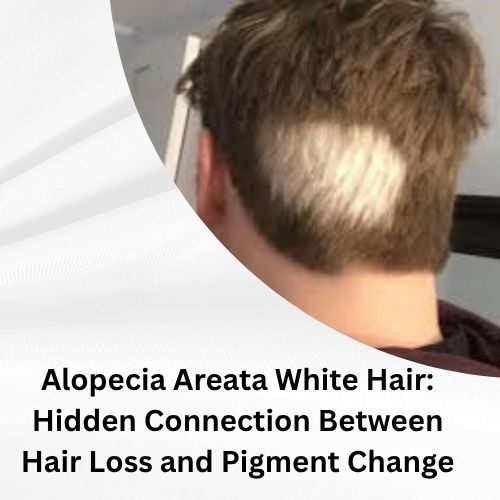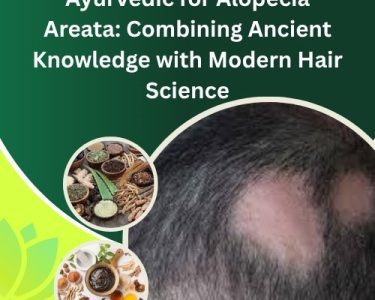Hair loss and pigment changes are two deeply interconnected phenomena that often surprise those experiencing alopecia areata white hair. While alopecia areata primarily involves patchy hair loss caused by autoimmune activity, many individuals also notice white or gray hairs regrowing in bald patches. This can be both confusing and concerning—but understanding the connection between hair pigment and hair loss provides valuable insight into what’s happening beneath the surface of your scalp.
In this comprehensive guide, we’ll uncover the hidden connection between alopecia areata and white hair, explore the causes, discuss treatment options, and explain related conditions like white vellus hair in alopecia areata, youthful hair loss problem and alopecia areata beard white hair.
Understanding Alopecia Areata and Its Impact on Hair Pigment
Alopecia areata is an autoimmune disorder where the body’s immune system mistakenly attacks healthy hair follicles, causing sudden hair loss in small, round patches. This condition affects both men and women and can occur at any age.
In many cases, when hair begins to regrow after an alopecia areata episode, it may come back as white, gray, or depigmented hair. This happens because the immune attack can also damage melanocytes—the cells responsible for producing melanin, the pigment that gives hair its color.
Over time, as the follicles recover, pigmentation may return, and the hair can regain its natural color. But in some cases, white hair after alopecia areata can persist.
Alopecia Areata White Hair – The Root Cause Behind Pigment Loss
Alopecia Areata white hair refers to the occurrence of white or colorless hair in areas previously affected by alopecia areata.
When hair regrows after a bout of autoimmune hair loss, many patients notice that their new strands appear white or light gray. This is a clear indication that the melanocytes within the hair follicles have been affected.
Why Does Hair Turn White After Alopecia Areata?
- Autoimmune Response: The immune system targets not just the hair follicle but also the pigment-producing cells (melanocytes).
- Melanin Depletion: Damage to melanocytes leads to a temporary or permanent loss of pigment.
- Regrowth Phase: As follicles begin to heal and produce new hair, the initial regrowth may lack melanin, resulting in white hair.
- Oxidative Stress: Inflammation during alopecia areata increases oxidative stress, accelerating pigment loss.
Emotional Impact
For many individuals, seeing white hair in alopecia areata can be distressing. It’s a visible reminder of the condition and its unpredictable nature. However, it’s crucial to remember that pigment may return as the follicles recover fully.
Alopecia Areata White Hair Treatment – Can Pigment Be Restored?
One of the most common questions among those dealing with alopecia areata white hair is: Can my hair color come back?
The good news is, yes—in many cases, pigmentation can return over time with the right combination of Natural Treatment for Alopecia Areata, healthy lifestyle habits as the follicles and melanocytes heal. However, the process can be slow and unpredictable.
Effective Alopecia Areata White Hair Treatments
Corticosteroid Therapy
Corticosteroid creams or injections can reduce inflammation and suppress the immune attack on hair follicles, promoting both hair regrowth and potential pigment recovery.
Topical Immunotherapy
Medications like DPCP (diphencyprone) or SADBE are applied to the scalp to stimulate an immune reaction that distracts the immune system from attacking hair follicles.
Minoxidil (Rogaine)
Minoxidil helps stimulate new hair growth, including white vellus hairs, and with continued use, pigment may gradually return.
Platelet-Rich Plasma (PRP) Therapy
PRP uses your blood’s growth factors to promote hair follicle repair and melanin regeneration.
Natural Remedies and Supplements
Natural Alopecia Herbal Supplement and Vitamins like B12, D3, E, and minerals like zinc and iron support melanin production and overall hair health.
Can Pigment Return Naturally?
In many cases, yes. Once inflammation subsides and melanocytes recover, white hairs may darken over time. However, if melanocytes are permanently destroyed, the white hair may remain.
White Hair After Alopecia Areata – What It Means for Recovery
The appearance of white hair after alopecia areata is often seen as a positive sign of follicle recovery. It indicates that hair growth has resumed, even if the pigment is temporarily missing.
Stages of Hair Regrowth After Alopecia Areata
- Dormant Stage: No visible hair growth.
- Regrowth Stage: Thin, colorless vellus hairs start to emerge.
- Pigment Return Stage: Over time, melanocytes may repopulate, restoring hair color.
This pattern shows that white hair after alopecia areata is a normal and often hopeful sign—it means your follicles are still alive and functioning.
How Long Before Hair Regains Color?
The time varies by individual. Some see color return within months, while others may have persistent white patches for years. Lifestyle factors, stress, nutrition, and treatment consistency all influence recovery.
White Hair in Alopecia Areata – The Science Behind Pigment Loss
The phrase “white hair in alopecia areata” describes how depigmented hair appears during or after autoimmune hair loss.
Scientific Explanation
Hair pigmentation depends on melanin synthesis within the follicle’s melanocytes. In alopecia areata, the immune system attacks both follicular keratinocytes (which make hair) and melanocytes (which color hair). This dual assault leads to:
- Patchy hair loss
- Colorless regrowth
- Irregular pigment distribution
In essence, white hair in alopecia areata reflects deeper immune-related damage beyond mere follicle inflammation.
Pigment Change vs. Hair Loss
Interestingly, pigment-producing cells seem more vulnerable to immune attacks than hair-producing cells. This explains why white or gray hair often appears before or after bald patches heal.
White Vellus Hair in Alopecia Areata – Early Sign of Regrowth
When recovery begins, white vellus hair in alopecia areata is one of the first visible signs of healing. These are fine, soft, and colorless hairs that emerge from recovering follicles.
What Are Vellus Hairs?
Vellus hairs are thin, non-pigmented strands that resemble baby hair. They appear before terminal (thicker, colored) hairs return.
What Does It Mean for Patients?
- Positive Indicator: The follicles are active and starting to grow again.
- Transition Phase: With proper care, these vellus hairs can develop into normal, pigmented hair.
- Treatment Focus: Encouraging blood flow, reducing inflammation, and supporting melanocyte function help convert vellus to terminal hair.
Treatment Tips for White Vellus Hair in Alopecia Areata
- Continue topical or oral treatments prescribed by a dermatologist.
- Use gentle scalp massage to improve circulation.
- Include melanin-boosting nutrients like copper, vitamin B12, and folate.
Alopecia Areata Beard White Hair – Understanding the Facial Connection
Alopecia areata doesn’t only affect the scalp—it can also appear on the beard area, leading to alopecia areata beard white hair.
Men often notice patches of white or bald areas in their beard, which can be quite noticeable.
Causes of White Hair in Beard Alopecia Areata
- Autoimmune Attack: Similar to scalp alopecia, immune cells target beard follicles.
- Melanocyte Damage: Loss of pigmentation cells leads to white or depigmented beard hair.
- Stress and Genetics: Both play significant roles in the onset of autoimmune beard conditions.
Is It Reversible?
In many cases, white beard hair due to alopecia areata may regain color if treated early. Therapies like corticosteroid injections, PRP, and microneedling have shown positive outcomes.
Self-Care Tips
- Maintain beard hygiene and moisturize regularly.
- Avoid shaving over inflamed patches.
- Manage stress and sleep patterns to reduce flare-ups.
Alopecia Areata Beard Cause White Hairs – The Immune Link
The term “alopecia areata beard cause white hairs” highlights the immune-related nature of beard depigmentation. Essentially, when the immune system attacks pigment cells, white hair appears even without total hair loss.
Key Factors Behind Beard White Hair in Alopecia Areata
- Autoimmune Reaction: The immune system confuses beard follicle cells as foreign.
- Localized Pigment Loss: Melanocytes in beard follicles are destroyed or suppressed.
- Nutritional Deficiencies: Low B12, copper, or folate levels worsen pigment loss.
- Oxidative Stress: Free radicals damage pigment cells in the beard area.
How to Manage Beard White Hair from Alopecia Areata
- Topical Minoxidil: Encourages new beard growth and may support pigmentation.
- Immunomodulatory Creams: Reduce local immune activity.
- PRP Therapy: Rejuvenates follicles and may reactivate pigment production.
- Diet and Supplements: Include foods rich in antioxidants, B vitamins, and minerals that support hair color restoration.
Can White Hair from Alopecia Areata Turn Back to Normal?
This is one of the most common questions patients ask. While not all white hair from alopecia areata regains color, pigmentation recovery is possible in many cases with time and treatment.
Factors That Influence Pigment Recovery
- Severity of Immune Damage: The more melanocytes destroyed, the harder it is to regain pigment.
- Duration of Condition: Long-term alopecia areata may lead to permanent pigment loss.
- Treatment Consistency: Early and sustained treatment increases chances of normal regrowth.
- Genetic and Lifestyle Factors: Nutritional health, sleep, and stress levels affect pigment restoration.
Natural Remedies and Lifestyle Tips for Alopecia Areata White Hair
While medical treatments are essential, natural remedies and Ayurvedic for Alopecia Areata can complement recovery and support hair pigment restoration.
Dietary Support
- Copper-rich foods: Nuts, seeds, and shellfish help melanin production.
- Vitamin B12 and folate: Essential for hair color and growth.
- Antioxidant foods: Berries, green tea, and leafy greens reduce oxidative damage.
Lifestyle Tips
- Reduce stress with meditation or yoga.
- Get enough sleep and hydration.
- Avoid harsh chemical treatments on affected areas.
- Use natural oils (castor, coconut, rosemary) to nourish follicles.
Supplements for Support
- Biotin: Enhances hair strength and regrowth.
- Vitamin D and E: Support immune regulation and scalp health.
- Zinc: Promotes follicular healing and pigment cell recovery.
Final Thoughts
The link between alopecia areata and white hair lies in the delicate balance between autoimmune activity and melanocyte function. When inflammation affects both hair follicles and pigment cells, the result is hair regrowth that appears white or colorless.
Whether on the scalp or in the beard, these white hairs often indicate recovery—and with the right alopecia areata white hair treatment, many individuals regain both their hair and its natural color.
Though the journey may take time, combining medical therapy, proper nutrition, and stress management can help restore confidence and natural pigmentation.




